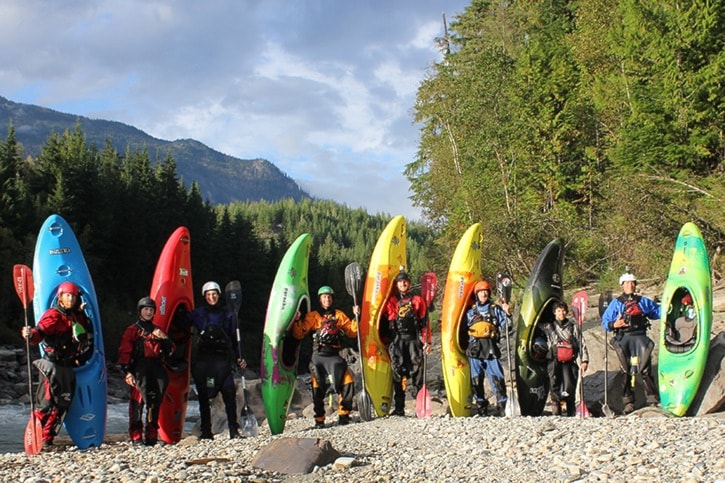Six-day wilderness expedition brought them over mountain pass, along a never-explored river and through 2,000-year-old cedar stands
“Exhilaration and levitation.”
That was how Carl Jacks described the sensation of completing a first ever descent of the Incommapleux River last week.
Jacks made the trip with seven other kayakers and a hiker, Steve Ogle, who was there to document the expedition. The trip brought them through vast forests of Glacier National Park, across many alder-filled avalanche paths and, finally, down the fast-moving and overflowing Incommapleux River.
The crew, which included three Revelstokians, set off on Tuesday, Sept. 3. The trip started with 2.5 days of hiking through Glacier National Park, followed by 3.5 days of kayaking down the Incomappleux River.
I met half the group while they enjoyed a post-expedition dinner at the Village Idiot in Revelstoke on Sunday night. I sat down with Jacks, Randy Speers, Sam Butler and Sven Perschmann as they enjoyed some beers and a greasy meal of poutine and pizza. The other four members of the group – Revelstoke’s Sean Bozkewycz, Christian Foster and Sam Ewing; and Stephan Paetsch – had just missed the ferry and didn’t make it to the restaurant while I was there.
Jacks and Speers took the lead in talking about the trip – the excitement and thrill of having completed a true wilderness adventure greatly evident.
“It was a world class adventure trip,” said Speers.

The aim of the trip was not only to paddle the river, but also to document the remote upper Incomappleux valley to help the Valhalla Wilderness Society in its mission to protect the river as a park.
They talked about the slog over Flat Creek Pass, the painful bushwhacking through devil’s club, the unexpectedly high water on the river, the majestic old-growth cedars the abundant huckleberries and the grizzly bears they saw.
First was the hike with 100 pounds of gear, in the rain, through 13 kilometres on a little travelled and sometimes-disappearing trail in Glacier National Park. They left from just inside the park’s western boundary, with their kayaks and everything else on their backs, and their paddles in their hands. It took them through classic Interior hemlock forest, up through the pass, past the Fortitude warden’s cabin, and down the steep slopes along Slick Creek.
“The hike was awesome. So many huckleberries and blueberries. I saw two grizzlies,” he said, adding: “It was one of the most physically demanding things I’ve ever done.
“You can use my word, ‘Funishment.’”
Jacks seconded him on behalf of the rest of the group. “The trail was on a God send but at the same time I think everyone agreed it’s the most difficult thing they’ve ever done as far as long-days and hour after hour of just grinding through.”
It took 2.5 days to reach the river. Perschmann called the feeling of reaching the river “euphoric.”
“There was a locked in feeling that once we got down to the river, there was no way we were getting out but the river,” added Jacks. “We were faced with a complete unknown, and it was raining even more, which changed it.”
The crew had seen aerial photos of the river taken 10 years ago, but the river had changed. Avalanche paths flowed from the glacier-capped peaks right into the river. Landslides they believe were caused by the June floods had sent big debris flows into the river, altering its course. As well, the water level in the river was higher than expected, the result of constant rain throughout the week. The river came up two feet one night, they said.
“It resulted in some of the most ridiculous portages we have ever done,” said Jacks.
The going through the water was fast, but when they were forced onto land, they moved at snail’s pace, crawling with their boats through alder and devil’s club-filled slide paths. They spoke of the many blisters and cuts they received.
“Everyone’s got devil’s club in every part of their body right now,” said Jacks, showing me his red hands. “You can’t see them but you can sure feel them.”
On ground they could witness the majesty of the forest they were in. Some of the portages took took them past ancient cedars that were several hundred feet tall and more than 10-feet wide.
“It’s like you’ve been shrunken down to half your size,” said Jacks. “You’re in the biggest forest you’ve seen, but now it’s double that.”
Speers said one of his best memories was walking through a grove of cedars all more than three metres wide. “It’s probably 2,000-years-old.”
The landscape was wet and mossy. They could walk around barefoot while camping, the ground was so soft.

One of the main features of the river – a kilometre-long box canyon – proved too risky to kayak. A big waterfall barred the entrance, and, even if they could get in, the high walls and lack of exits meant it was too risky. They walked around. Half the group paddled the lower section, but they all walked around the top half.
Eventually they made it through the first 17-kilometres of unroaded wilderness to the confluence of the Incomappleux with Battle Brook, into areas some had paddled before. From there, it was down to the Upper Arrow Lake at Beaton where their trucks and a few cases of beer were awaiting. They reached the end Sunday afternoon. Three of them had celebrated their birthdays on the route.
“The sun came out as we piled our kayaks on the beach and took a photo of everyone, and then lots of hooting and hollering,” said Jacks.
They were already talking about going back, but not for a few years – and when the water is lower. There’s a number of sections they didn’t run, leaving portions of the river untapped.
“Will it happen again? Hard to say,” said Jacks. “I think we all agreed we’d do it again, but not for a year or two.”
